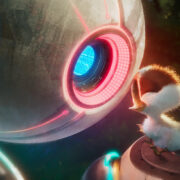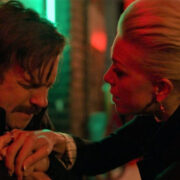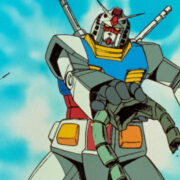BLOODY SPEAR AT MOUNT FUJI: A Samurai Masterpiece From Legendary Director Tomu Uchida

Film critic, Ithaca College and University of St Andrews graduate,…
There’s only one fight scene in Bloody Spear at Mount Fuji. It arrives in the film’s final 10 minutes. It’s clumsy, violent, and so well-choreographed that it looks almost badly choreographed. So watchable and grotesque is the scene, full of bloody chaos, bleary-eyed rage, and frenzied combat, that it easily ranks among the best samurai fights ever committed to film.
The movie as a whole, unfortunately, does not get the same love or attention as its more stylistic samurai film counterparts. It’s fallen through the cracks. The same can be said of its director, Tomu Uchida, who is a legend in Japan yet virtually unknown in the West. He had a formidable career, celebrated first for his leftist pre-war films and then for his robust and variegated genre work throughout the postwar years until his death in 1970. Bloody Spear at Mount Fuji follows a strange gap in his resume — after the war, Uchida lived in Manchuria for a decade and a half, and upon his return, Bloody Spear was the first film he made, releasing in 1955. The film was produced with the help of Uchida’s Japanese director friends — Daisuke Itô, Hiroshi Shimizu, and Yasujirô Ozu are all credited as “advisors to the production.”
Akira Kurosawa’s Seven Samurai had just come out the previous year, so Uchida’s film was birthed into this vast landscape of great samurai pictures that were just beginning to find international recognition. Kurosawa’s samurai classic bears many of the same themes and only takes place a few decades before Uchida’s, yet the two could not be more different. Where Kurosawa draws a small band of relatively uncomplicated heroes together for a series of grandly staged battles, Uchida’s narrative lacks that central focus. The film is messy and dissonant, a tight 94 minutes that juggle a dozen principal characters and refreshingly low-stakes action. Where Bloody Spear at Mount Fuji’s ending is one big, furious swing, the rest of the picture is resplendent, gentle, even laid back, at once employing samurai tropes and subverting them, offering a complex rewriting of Japanese national mythology.
Jiro Dreams of Spear-Carrying
The titular spear belongs to Lord Sakawa (Eijirô Kataoka), a samurai bound for Edo. Right away, we can tell something’s different here: Sakawa’s secretly a habitual drunkard, and his servants are told that the lord should not touch alcohol for the duration of the journey. There’s no noble quest or lofty goal; Sakawa’s going to see his family, and his holy cargo is but a single precious bowl.
Sakawa’s servants play a larger role in the story than he does. His aide, Genta (played by Daisuke Katō, one of the surviving samurai of Kurosawa’s film), spends his nights lost in sake, while his spear-carrier, Gonpachi (Chiezô Kataoka), is slow, ungraceful, and beset by blisters. In the opening scene, Uchida introduces us to these three alongside the rest of our band of travelers: a father selling his daughter into prostitution to pay off a debt; a mother-and-daughter pair of entertainers; a resolute lawman; a shady miner concealing a small fortune; and a young orphan, Jiro (Motoharu Ueki), who idolizes the spear-carrier.
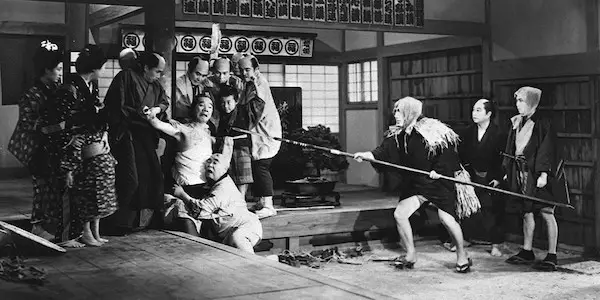
With his puckish grin and devilish screeches, Jiro behaves like a puppy nipping at Gonpachi’s heels the whole trip. The two child actors here are the real-life children of Gonpachi’s actor, Kataoka, imbuing all of their scenes with tender, familial joviality. Jiro’s relationship with Gonpachi instantly becomes one of the film’s most heartwarming subplots, and they provide the film with its most charming and offbeat scenes.
Upon arriving at his lodging for the night, Gonpachi drops some cold coins down the back of the boy’s shirt, like ice cubes, and the kid has to disrobe in the street to shake them loose. He spends the money not on a place to sleep but on way too many persimmons, which give him diarrhea the next day. There’s a very long patch of this movie where the primary conflict is boy-versus-indigestion. While some nobles having a tea ceremony block off the path, Jiro has to go. Not only do the characters stop so Jiro can make a roadside deposit, but — and this is where it gets great — there are story developments that result from this. The entire last third of the film would be different had the kid not gotten the runs!
Sake House Rules
Bloody Spear at Mount Fuji has a large cast to contend with, and Uchida gives them all the requisite love and care. One of the film’s standout scenes finds the master, Sakawa, in a sake house with Genta. The servant struggles to keep the master from drinking, though Sakawa starts amicably enough. He insists on Genta drinking in peace, then respectfully asks for a single cup so the other patrons don’t think Genta’s drinking alone. By the time we cut back to them, Sakawa’s loaded.
The editing, from Shintarô Miyamoto, emphasizes Sakawa’s sly, shaky menace and the visceral discomfort Genta feels as he realizes he’s being backed into a corner and can only watch as his lord drinks more and more sake. And as Sakawa slurs his words, throwing accusations at Genta and starting trouble, it’s kind of hard for your face not to twist into a smile. Sure, it’s frightening to watch him threaten Genta, but seeing the servant fail so miserably at the one thing he was supposed to do is extremely fun.
Cinematographer Sadaji Yoshida, along with the film’s editor, was a frequent collaborator of director Eiichi Kudô’s. For Bloody Spear at Mount Fuji, Yoshida favors a wide-open frame. In the interior of the sake house, for example, this technique fits in as much of the cast as possible. In the exteriors, the open-top third of the frame accommodates the tall spear, frequently towering over the characters.
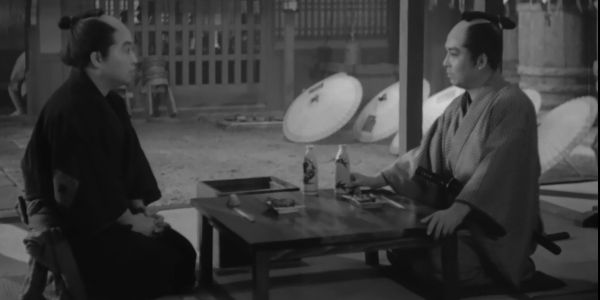
Bloody Spear is not without its standout shots — an early one pairs Jiro with Gonpachi, walking down the road at midday, the sun throwing their long shadows over the trail. A later scene with Gonpachi and Jiro finds them on the beach with the traveling entertainers. Just four people, the sand, the surf, a small home, and the mountains looming in the distance. There’s hardly any talk in Bloody Spear about the “quiet life,” about what would happen if Gonpachi hung up his spear and became a farmer, but this single shot evokes the pastoral nevertheless, teasing the possibilities open to Gonpachi if he were to leave with the entertainer and her daughter and turn over a new leaf.
Along with its spirited script and layered compositions, the film boasts an instantly iconic soundscape. Though there are often long patches of quiet, the early scenes in the town feature a far-off flute melody and the drum beats of a distant festival. I might not be able to keep the characters straight, but if I heard that flute and those drums, I’d immediately be transported back into Bloody Spear at Mount Fuji. The music creates this aural liminal space, where the characters are neither part of the festival nor outside of society, merely passing through.
During the whole film, you get the sense that you’re watching people living in the shadow of something greater. The film reminds you of this by occasionally cutting away to gorgeous matte paintings of Mount Fuji, and by sometimes using wide shots framing the characters against endless fields or rolling hills. These travelers, who are almost all of a lower class, are dwarfed by the immensity of the world they’re in, like aphids on a leaf of a great oak tree.
The film shines its spotlight on the peripheral players of the samurai story, showing us a side of this world we’d never considered before, and this perspective takes some getting used to. On a second watch, I found it far easier to settle into the film and appreciate its quiet character beats and subtle charm rather than worry about the mechanics of its story or the jidaigeki tropes I expected to see.
Ship Of Fools
With its “ship of fools” structure, ensemble cast, and violent payoff, Bloody Spear at Mount Fuji is clearly inspired by John Ford’s Stagecoach, in which an unlikely gang of cowboy-story stereotypes ventures across the Mojave Desert. Uchida’s film is head and shoulders above Ford’s, of course, bearing a lightness of tone and a graceful sophistication and empathy for its characters that Ford could never conceive of. Where Ford’s characters mostly remain static, in Bloody Spear at Mount Fuji, everyone has fundamentally changed by the end of the story.
The screenplay, from Kintarô Inoue, Shintarô Mimura, Toshio Tamikado, and Fuji Yahiro, plays with our expectations of samurai films and actively undermines a genre that had heretofore formed the backbone of nationalistic Japanese cinema. Bloody Spear criticizes feudal Japan, which, in samurai films, is the setting of honorable, noble warriors who wage great wars and experience lofty victories and holy sacrifices. The film instead characterizes the Edo period as a dirty, fraudulent world rife with children with diarrhea, samurai with sore feet, and drunken masters who can’t even win a swordfight. The premise and title draw you in with promises of bloody fights and samurai action, only to give you honest, heartfelt character drama. That duplicity is wholly in keeping with the central theme of Bloody Spear at Mount Fuji — perception versus reality. Maybe it’s because the period Uchida’s film is set in was 200 years ago, while Ford’s film covered recent history. The samurai story had more time to reflect and mature.
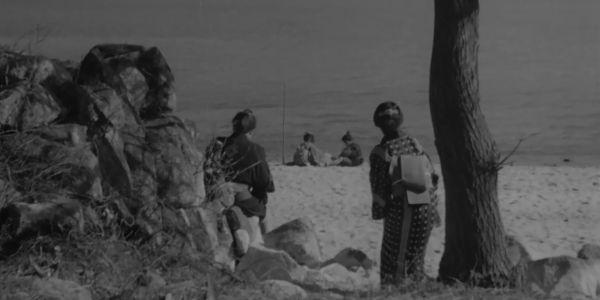
Everything in Bloody Spear at Mount Fuji unfolds patiently — not only its historical criticism and its genre subversion but its character arcs as well. Uchida endears us completely to every member of his cast, delivering an effective, if often sentimental, knot of stories. One of the most affecting is that of the old man selling his daughter into prostitution. The film pushes the father (Unpei Yokoyama) to his breaking point, and he gets more resigned and somber as the film marches on. Yokoyama was also, it happens, one of the first Japanese film actors — he was the lead in the first official motion picture made in the country, giving Bloody Spear one foot in the present as well as in the past.
But Gonpachi ultimately owns the film — the man who enters the story as a bad spear-carrier leaves a great samurai, but only after he’s pushed to extreme violence. Kataoka embodies this exuberant, giddy old man forced by an indifferent, unjust, dog-eat-dog world into becoming a cold-hearted killer, and the only reason he gets away with it at all is that the law considers him to be a lowly servant. And so we get our final shot, when Gonpachi walks off into the afternoon, over a hill, and our last glimpse of him is his spear, just visible over the horizon, bobbing up and down as its carrier walks away, like an army of one slouching to war.
Conclusion
World War II completely changed the kinds of films Uchida made. Much of his pre-war output is lost or cut down to oblivion, but by all accounts, his postwar work tended to be more nihilistic and tragic than his pre-war films. Each of these movies comments on either the war or Japanese postwar society, and Uchida’s big comeback project, Bloody Spear at Mount Fuji, reflects that focus, too.
The film calls into question the honor and heroism of samurai and the shogunate, which had until that point been fixtures of Japanese nationalistic image. Unglamorous characters with wanting, unfulfilled lives complicate the idyllic Edo period of more conventional genre fare. Uchida also spits on the overly hierarchical society and its rigid class system, and he openly mocks the ridiculous rules that propped it up. Perhaps that’s why Uchida’s film — and by extension, Uchida — is less well-known in the west. It was too knowing, too subversive, and too critical.
After the end of the war, the samurai film surged in popularity, with dozens being produced each year. And while some flocked to these for escapism and to be reminded of simpler days, when the Japanese fought amongst themselves rather than overseas, others, like Uchida, had become disillusioned with the genre and sought to paint over these maggot-eaten samurai tropes with a modern context, discussing social issues like alcoholism, women’s rights, and national trauma. He brought 20th-century anxieties to 18th-century Japan, including rigid scrutiny of the need for violence in samurai films.
The irony of the ending is that the violence isn’t noble or just or worth anything at all. You’re not supposed to enjoy watching the fight, yet the choreography, composition, and editing are so dynamic and tense that you can’t help but watch. It’s the kind of denouement that no other samurai movie of the time would go for. What makes Uchida’s film a masterpiece is how it’s able to cast the genre’s well-worn clichés to the side, and when it does pick them up and dust them off, it’s in the service of surveying, like an archaeologist, the palaces and tombs and sake houses of the past and making sense of them.
What’s your favorite samurai film? Have you seen Bloody Spear at Mount Fuji? Let us know in the comments below!
Bloody Spear at Mount Fuji is available to watch on Arrow.
Watch Bloody Spear at Mount Fuji
Does content like this matter to you?
Become a Member and support film journalism. Unlock access to all of Film Inquiry`s great articles. Join a community of like-minded readers who are passionate about cinema - get access to our private members Network, give back to independent filmmakers, and more.
Film critic, Ithaca College and University of St Andrews graduate, head of the "Paddington 2" fan club.




